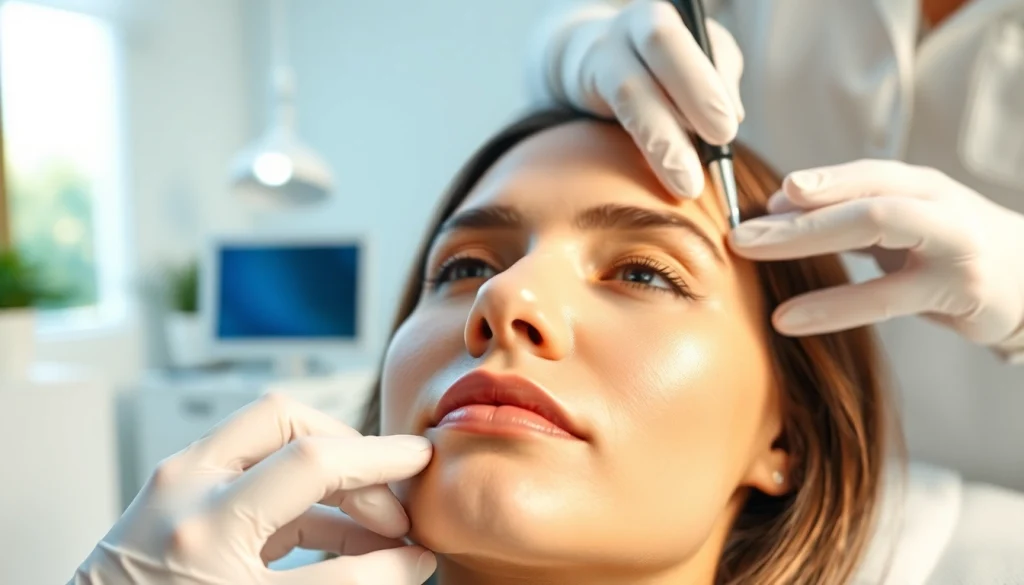
What is Nasolabial Fold Filler?
Definition and Purpose of Nasolabial Fold Filler
Nasolabial folds, often referred to as “laugh lines,” are the creases that extend from the edges of your nose to the corners of your mouth. As we age, these folds tend to become more pronounced due to a loss of elasticity and volume in the skin. To address this aesthetic concern, many individuals turn to nasolabial fold filler treatments, which involve the injection of dermal fillers to restore volume and smoothness. The primary purpose of these fillers is to rejuvenate the facial contours, enhancing one’s appearance while maintaining a natural aesthetic. The procedure can significantly reduce the visibility of nasolabial folds and create a more youthful look. However, understanding the different types of fillers and their suitability for various individuals is crucial before pursuing treatment.
Types of Fillers Used for Nasolabial Folds
Several types of dermal fillers are utilized to mitigate nasolabial folds, each with unique properties and benefits. The most common fillers include:
- Hyaluronic Acid (HA) Fillers: These are among the most popular options due to their biocompatibility and ability to retain moisture, providing a natural plumpness. Examples include Juvederm and Restylane.
- Calcium Hydroxylapatite Fillers: This type, such as Radiesse, acts as a scaffold under the skin while stimulating collagen production, offering longer-lasting results.
- Permanent Fillers: These include substances like polymethyl methacrylate (PMMA). While they provide lasting results, they require careful consideration due to potential complications.
Each filler varies in texture, longevity, and suitability, making it essential to have a consultation with a qualified practitioner to determine the most appropriate option for your specific needs.
Who is a Suitable Candidate for Treatment?
The ideal candidates for nasolabial fold filler treatments are typically adults who are experiencing noticeable volume loss in the midface area. Individuals in good health, without a history of severe allergic reactions to ingredients found in fillers, are often considered suitable. Factors to consider include:
- Age: While treatment is common in older adults, younger individuals may seek preventative measures against wrinkles.
- Skin Type and Tone: Those with moderate to severe folds might benefit the most from treatment, as results can be more noticeable.
- Expectations: Candidates should have realistic expectations and understand that fillers can improve appearance, but they are not permanent solutions.
Consultations with a qualified professional can help ensure that the individuals who seek treatment understand the process and outcomes.
Benefits of Nasolabial Fold Filler
Immediate Aesthetic Improvements
One of the most significant advantages of nasolabial fold filler is the immediate enhancement in appearance post-treatment. Patients typically notice the following:
- Smoother Complexion: Fillers effectively reduce the visibility of wrinkles and folds, contributing to a more youthful complexion.
- Defined Facial Contours: By restoring volume, fillers help to define the cheek and jawline, lending a more sculpted look to the face.
- Individual Variability: Results can be tailored; different densities of fillers can provide varied effects, allowing the practitioner to customize treatments based on individual needs.
Long-Lasting Effects and Results
While results from nasolabial fold filler treatments can vary, many patients experience effects lasting anywhere from six months to two years, depending on the type of filler used. Factors influencing longevity include:
- Type of Filler: Hyaluronic acid fillers typically last six to twelve months, while calcium hydroxylapatite fillers may last longer due to their collagen-stimulating properties.
- Metabolism: Individual metabolic rates affect how quickly the body absorbs the filler.
For individuals who desire a longer-lasting result, regular follow-up treatments can help maintain their appearance over time.
Boosting Confidence and Self-Esteem
Beyond the physical aspects, the psychological benefits of nasolabial fold filler treatments can be profound. Many individuals report:
- Enhanced Self-Confidence: Improved aesthetics can lead to a boost in self-esteem and a more positive self-image.
- Social Engagement: Feeling more comfortable in one’s skin can lead to increased social interactions and engagement.
- Empowerment: Taking control of one’s appearance can make individuals feel more empowered, investing in their well-being and happiness.
These emotional benefits contribute significantly to the popularity of cosmetic procedures today.
The Nasolabial Fold Filler Procedure Explained
What to Expect During the Treatment
Nasal fold filler procedures are generally quick and minimally invasive, often completed within 30 minutes. Here’s what patients can expect:
- Consultation: A thorough consultation to discuss goals, evaluate skin, and plan treatment.
- Preparation: The area is cleaned, and a topical numbing cream may be applied for patient comfort.
- Injection: Using a fine needle, the filler is injected into the targeted areas. Patients may feel slight pressure or a pinch.
- Immediate Results: Patients can often see immediate changes, with optimal results developing over a few days.
Though most individuals can resume their daily activities shortly after the procedure, they should be mindful of any aftercare instructions provided by their practitioner.
Preparation for Your Appointment
Proper preparation can help ensure a smooth and successful treatment. Consider the following steps before your appointment:
- Research and Consultation: Investigate potential practitioners and schedule a consultation to discuss your goals and any concerns.
- Avoid Certain Medications: Blood thinners, such as aspirin and ibuprofen, should be avoided at least a week before treatment to minimize bruising.
- Hydrate: Drinking plenty of water leading up to your appointment can enhance overall skin vitality.
Discuss any allergies or medical conditions with your practitioner for the best outcome.
Understanding the Techniques Used
Practitioners employ various techniques to optimize results from nasolabial fold filler treatments:
- Linear Insertion: This method involves a straight technique of injecting filler directly into the nasolabial fold.
- Point Injection: Small amounts of filler are strategically placed at multiple points along the fold.
- Fan Technique: This technique allows for a more diffused approach, distributing filler along a broader area for a natural look.
Each approach has its advantages and may be selected based on the patient’s facial structure and the desired outcome.
Aftercare for Nasolabial Fold Filler
Post-Treatment Care Guidelines
Following nasolabial fold filler treatment, adhering to specific aftercare guidelines can optimize results and minimize complications:
- Avoid Touching the Area: Direct pressure or manipulation of the treated area should be avoided for at least 24 hours.
- Ice Application: Applying ice packs can help reduce swelling and discomfort.
- Sleep Position: Sleeping on your back for the first night can help prevent undue pressure on the filler.
These simple measures can significantly enhance the longevity and effectiveness of the procedure.
Common Side Effects to Watch For
As with any cosmetic procedure, nasolabial fold filler injections may result in side effects, including:
- Swelling: Mild swelling is common and usually resolves within a few days.
- Bruising: Small bruises may occur at the injection sites, especially in sensitive individuals.
- Redness: Minor redness can appear post-injection; however, it usually diminishes quickly.
It’s important for patients to monitor their condition and inform their practitioner of any concerning changes.
When to Contact Your Practitioner
If any unexpected symptoms arise post-procedure, contacting your practitioner is essential. Signs to watch for include:
- Severe Pain: Intense or persistent pain in the treated area should be assessed.
- Infection Signs: Uncontrolled redness, warmth, or pus around the injection sites.
- Allergic Reactions: Itching or swelling beyond typical post-treatment reactions.
Open communication with your practitioner is key to ensuring safety and satisfaction following treatment.
Cost and Considerations for Nasolabial Fold Filler
Evaluating Your Budget for Treatment
The cost of nasolabial fold filler treatments can vary widely based on several factors, including geographical location, provider expertise, and the type of filler used. Average costs can range from several hundred to over a thousand dollars per treatment. It is essential to:
- Assess Your Budget: Determine how much you are willing to spend before your consultation.
- Consider Long-Term Costs: Regular maintenance and follow-up treatments can add to overall expenditure over time.
Financial feasibility is a vital consideration when planning for aesthetic treatments.
Factors Influencing Cost of Nasolabial Fold Filler
Numerous factors contribute to the final cost of treatment:
- Type of Filler: Premium fillers may carry higher price tags but can offer longer-lasting results.
- Experience of the Practitioner: Well-established practitioners often charge higher rates, reflecting their expertise.
- Location: Urban areas may have higher treatment costs due to increased demand and overhead expenses.
Understanding these factors can help patients make informed decisions about their treatment options.
Choosing a Qualified Practitioner
Selecting the right practitioner is paramount for achieving satisfactory results. Consider the following tips:
- Check Qualifications: Ensure that your practitioner is licensed, experienced, and specialized in aesthetic procedures.
- Read Reviews: Look for patient reviews and before-and-after photos to assess the quality of their work.
- Ask Questions: Do not hesitate to inquire about the practitioner’s techniques, the type of fillers used, and the expected outcomes.
A meticulous approach to choosing a practitioner can make a significant difference in your overall experience and satisfaction with the results.






